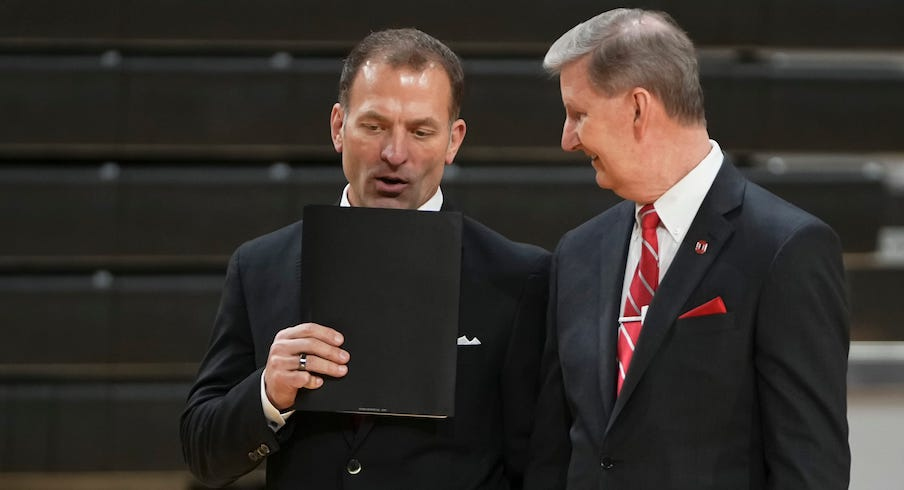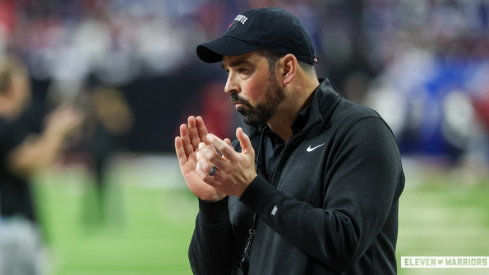As college sports move closer to a model in which revenue is shared directly with athletes, new Ohio State athletic director Ross Bjork and president Ted Carter know there will be major changes coming to the athletic department’s budget.
One change that neither of them wants or expects to make, however, is eliminating any of Ohio State’s 36 varsity sports.
During Bjork’s introductory press conference as Ohio State’s new athletic director on Wednesday, both he and Carter committed to doing everything they can to ensure the school doesn’t have to cut any sports.
“We owe that to the people. We owe that to our athletes. We owe that to our fans, to say we want to compete at the highest level at everything,” said Bjork, who will officially join Ohio State’s athletic department in March and take over for Gene Smith as athletic director in July. “It may look different. It may be reallocated different. It may be structured different. But we have unbelievable facilities. Those aren't going to sit empty, right? We have unbelievable infrastructure that's been built that allows us to have this foundation where we can be a broad-based program, for sure.”
Both Bjork and Carter also acknowledged, though, that Ohio State needs to prioritize its revenue-generating sports first. The football and men’s basketball teams were the only two Ohio State sports with higher revenues than expenses in Ohio State’s 2022 financial report to the NCAA – the most recent one released by the university – with football accounting for more than 43% of the athletic department’s total revenue during that fiscal year.
That said, Bjork believes there is great alignment within Ohio State’s athletic department in understanding the prioritization of those sports while still supporting each of its 34 other sports.
“Knowing what’s king – football, other revenue sports – we got to acknowledge that,” said Bjork, who played football at Emporia State. “And that's the great thing about here. There's a healthy culture that understands that and we can capitalize.”
As the budget is currently structured, Ohio State’s revenues from football and men’s basketball help subsidize the costs of the Buckeyes’ other 34 sports in addition to their expenses. In a likely future model where those revenues would be shared with Ohio State athletes, OSU will have to find additional revenue streams to fund its other sports.
“You're gonna see some sort of reallocation of the budget. And hopefully you can grow that budget,” Bjork said. “There's new revenue streams that are coming, right? College Football Playoff (expansion). Again, we want to capitalize on all the categories here on this campus.”
“Knowing what’s king – football, other revenue sports – we got to acknowledge that. And that's the great thing about here. There's a healthy culture that understands that and we can capitalize.”– Ross Bjork on prioritizing football and men’s basketball
One of the reasons why Ohio State hired Bjork, though, is because of his proven ability as a fundraiser.
“If we do go to any kind of revenue sharing, the amount of revenue that we bring in today, is going to be a little more difficult,” Carter said. “So managing the budget, managing the future of fundraising and how we're going to be able to manage the program this vast and this big is going to take some imagination, it's going to take somebody that's got the ability to show people what right looks like, and I believe Ross is that man to be able to do that.”
Depending on how the future of college sports ultimately evolves, there may come a time when it is no longer sustainable for Ohio State to fund 36 varsity sports programs. The model proposed by new NCAA president Charlie Baker, which would create a new subdivision in which schools would be required to pay at least half of their athletes a minimum of $30,000 per year, would cost Ohio State a minimum of $14.3 million if it maintains all 36 sports, according to an estimate published Wednesday by The Washington Post.
Even so, Carter and Bjork view the possibility of having to cut sports as a last resort.
“We're 36 Division I sports and that's the way I’m intending to stay,” said Carter, who played hockey at the Naval Academy. “Now, can that change in the future? Of course. The dynamics of where money will go and how it comes in, I mean, let's face it, there's two sports here, even as great as we are, The Ohio State University, that generate money. It’s football and men's basketball. There are some other programs in the country where some other sports generate a little bit more. So we're gonna have to think about revenue streams.
“But I've been around the block long enough that I've always been, and I was a student-athlete myself at Navy, I do not want to cut sports at all. And I've seen programs like Stanford and William and Mary go through that and then regret it and have to cycle back. I'd really like to not do that. So I'm gonna stand here and tell you that we have 36 Division I sports here. I refer to Gene in where we are today and Ross where we're going. But my intention is to keep 36 Division I sports.”


